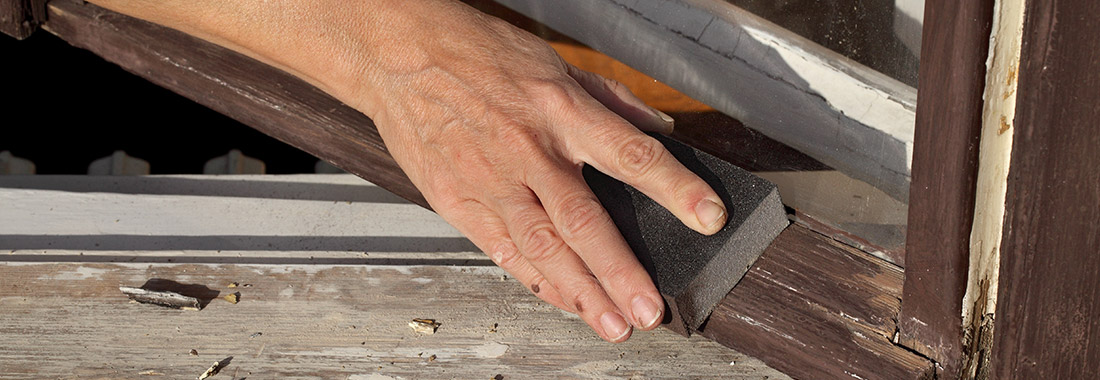

Suitable for an extensive range of everyday applications, abrasive pads and sponges are available in a wide range of shapes, sizes and specifications to suit all requirements.
However, choosing the right abrasive pad or sponge is important for ensuring the desired result is achieved. In terms of quality, performance and long-term reliability, abrasives differ significantly from one product to the next.
What is a sanding sponge?
A sanding sponge is a block of foam with an abrasive exterior that coats all sides and edges. It is similar in nature to an abrasive pad, with the exception of being significantly thicker and (usually) with a smaller surface area.
Some sanding sponges and pads feature different grits (or levels of coarseness) on each side, while others offer the same consistent coarseness throughout. Though somewhat more labour intensive than powered sanding, working with a sanding sponge or sanding pad allows for greater attention to detail from start to finish.
Abrasive sponges in particular have the capacity to conform to the more intricate grooves and curves along the material being worked on, which is often not the case with power sanders. Some types of sanding pads and sponges can be used both wet and dry, which can likewise contribute to the smoothness and consistency of the final result.
Why use an abrasive pad or sponge?
Just a few of the potential benefits of using an abrasive pad or sponge instead of a powered device include:
- Greater control over the finer details and the ability to produce consistent results.
- Using a wet sanding sponge reduces dust build up and delivers a less abrasive action on the surface.
- Quality abrasive pads and sponges can be used dozens of times for outstanding long-term value for money.
- Abrasive pads and sponges naturally conform to more difficult and awkward surfaces, producing more consistent results.
- They’re also comprehensively easy to work with – no specialist skills or knowledge required.
Abrasive pads and sponges are indispensable tools for the professional toolbox and home workshop alike, with limitless practical applications.
Choosing a sandpaper sponge or pad
The quality of the pad or sponge you buy will have a marked impact on its performance, along with the effort required to achieve the desired result. Quality is measured by the course surface material, along with the quality of the inner block or pad itself. The lower the quality of the abrasive, the more laborious the process and the higher the likelihood of a disappointing result.
It’s then simply a case of choosing the appropriate grit value to suit your requirements. This refers to the coarseness or smoothness of the abrasive surface – lower values indicating rougher surfaces, higher numbers applying to smoother surfaces.
As a general rule of thumb, abrasive pads and sponges should be selected in accordance with their intended application:
Abrasives for stripping
If you intend to strip a wooden surface back down to the bare wood for example, you’ll need to start out with a course grit. Choosing an abrasive pad or sponge with a grit value of 60 to 80 would be ideal, with the heavy-duty coarseness needed to tear paint or varnish from the surface of the wood.
Abrasives for prepping
When working with a bare surface in poor condition, a medium grit pad or sponge will help you prep it for priming and painting. Choose something with a coarse value of 100 to 150, which will allow you to remove most imperfections and create a smoother surface to work with.
Abrasives for finishing
Fine grit pads and sponges – typically between 180 and 320 – are ideal for sanding between coats of paint or primer. This will help the product adhere consistently and evenly to the surface, contributing to a great final result and a flawless finish.
How to use sanding sponges and pads
Using sanding sponges and pads is relatively easy, although here are a few helpful tips and guidelines from the experts.
It’s important to read the manufacturer’s guidelines before getting started to determine whether it’s better to use the abrasive wet or dry. Likewise, wearing the appropriate personal protective equipment (PPE) is also essential, as sanding surfaces tends to produce a lot of dust and potentially dangerous airborne particles.
Always sand in the direction of the grain, starting out with a courser abrasive and moving on to smoother grits for final finishing. In addition, it’s also important to give the surface a good wipe on a regular basis, as a surface coating of dust and debris will reduce the effectiveness of the sponge or pad.
After each use, clean your abrasive pad or sponge in accordance with the manufacturer’s guidelines, before storing it in a cool and dry place to maximise its lifespan.



